The best position of sleeping and appropriate pillow
"Good Sleeping Posture Helps Your Back and spine"
Most everyone knows that good posture is important, but good posture doesn't apply just to sitting and standing. The muscles and ligaments of your back relax and heal themselves while you sleep. In order to protect your back, good posture is important while sleeping. The position you sleep in has direct effects on your health. Sleeping position can affect your respiration, spinal alignment, and even wrinkling of the skin. There are proven ways to get a better night sleep by using the right pillow, with the right amount of fill, and sleeping in the right positions.
Your sleeping position and pillow work to provide proper support for your head, neck and spine. You need a pillow that conforms to and supports the curve of your neck with enough firmess to support your head without collapsing. It is fine to sleep on your back or your side (or both) as long as your spine is kept in a neutral position and not bent out of alignment.

Special attention is need for choosing the suitable pillow during sleep:
Side Sleeping Position
Sleeping on one’s side is the most common sleeping position – and one of the best positions for your back. When you lie on your side, your pillow needs to be thick enough to keep your spine straight, but not so thick it bends your neck out of alignment.
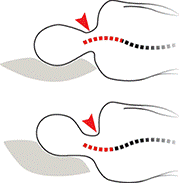
Bad position of head in side sleeping
Back Sleeping Position
Sleeping on one’s back is the second most common sleeping position after side sleepers. When you lie on your back many pillows do not properly support the space beneath your neck, causing muscle strain. If the pillow is too high when sleeping on the back, the neck is bent abnormally forward, causing muscle strain on the back of the neck and shoulders. This type of position may also cause narrowing of the air pipe, resulting in obstructed breathing, and sometimes snoring. Conversely, if the height of the pillow is too low, the neck muscles can be strained. Proper support and alignment of your neck and airway can sometimes lead to reduced snoring.
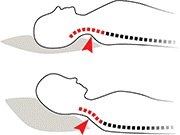
Bad position of head in back sleeping
Stomach Sleeping Position
If possible, avoid sleeping on your stomach as it’s difficult to maintain the proper spinal position. Sleeping on your stomach forces your head and spine into an unnatural upward bend. Staying in this position for hours on end is not good for your back or neck and can result is significant discomfort and restless sleep.
In general, studies suggest that sleeping with a pillow improves sleep quality and fits more physiologically and mechanically with the natural curve of the cervical spine. For most people, sleeping without pillow is not recommended, because increases intraocular pressure and risk of osteoarthritis in the neck
Important and applied points:
The best sleeping positions to do this are sleeping on your side or sleeping on your back. The most common sleeping position is on your side, with your legs and hips aligned and flexed.
If you sleep on your back, a small pillow under the back of your knees will reduce stress on your spine and support the natural curve in your lower back. The pillow for your head should support your head, the natural curve of your neck, and your shoulders.
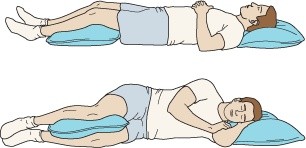
If you have varicose in legs, placing some pillows in a comfortable formation to get your legs elevated above your heart can help vascular system.
If you sleep on your stomach, a pillow for your head should be flat, or sleep without a pillow.
If your pillow is so soft, placing two soft pillows for increasing thickness is not recommend.
If you have allergy, asthma or chronic neck pain should be more carefully in choosing the right pillow.
It is better to replace your pillow that is used for night sleeping every 18 month.
Important point about Sleeping during pregnancy
The best sleep position during pregnancy is “SOS” (sleep on side). Keep your legs and knees bent, and put a pillow between your legs. This position improves circulation to the heart, which benefits both mom and baby. Sleeping on back is not recommended because of excessive pressure on lower veins (blood vessels that return blood from the legs to the heart) that can cause fainting feel. For providing proper support, pregnant women often use pillows under the abdomen or between knees to help them.
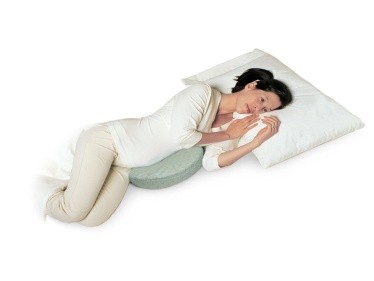
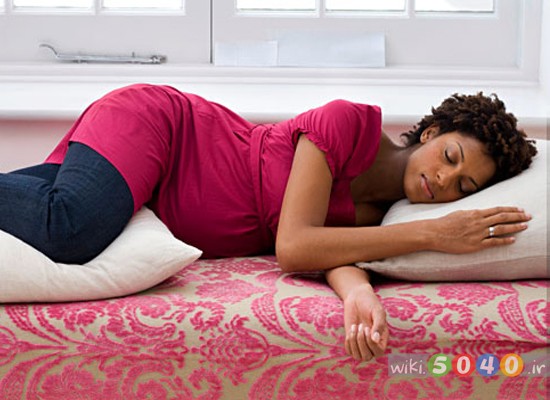
Important points for some problems
Low back pain: sleep on sides with a pillow under your belly. This creates support for the abdomen and waist to prevent muscle strain.
Asthma or shortness of breathing: Make sure you sleep on your side rather than your back. The left side is more suitable.
Leg cramps: If you wake up because of leg cramps, immediately straighten your leg and lift your toes toward your head. It improves muscle cramps and allows you to sleep again.
Carpal Tunnel Syndrome (CTS): CTS or median nerve impingement in carpal tunnel is a common problem in pregnancy with symptom of numbing tingling and pain in the fingers, hand, or wrist. Wear a wrist splint to bed if you have pain at night. It keeps your wrists from bending while you sleep, which contributes to pain.
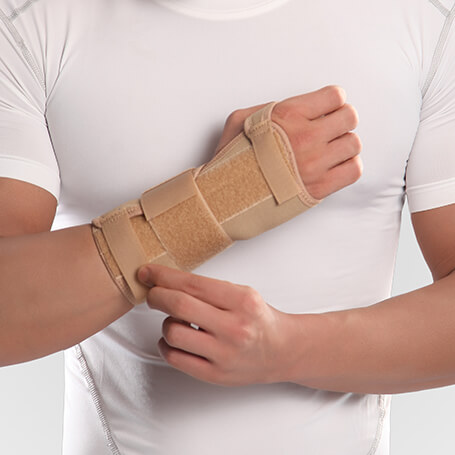
Neoprene wrist splint (with hard bar)

Long wrist splint (with hard bar)
Your comment successfully stored, thanks. Unfortunately comment storage process failed.